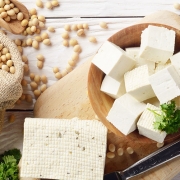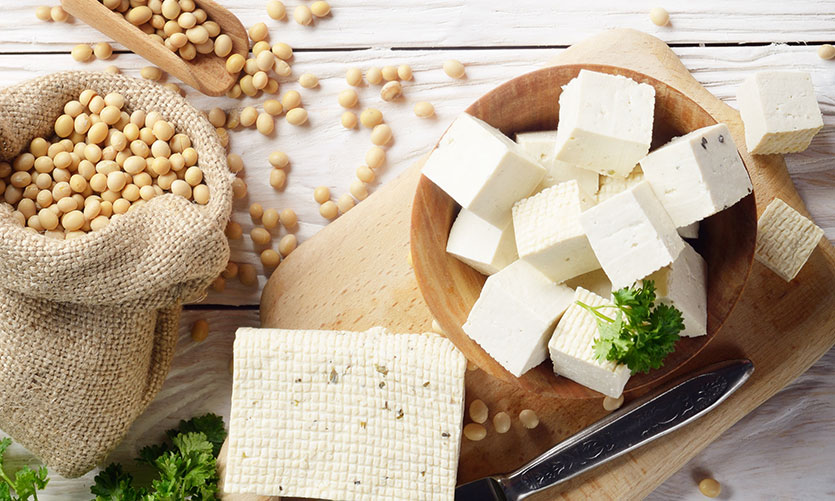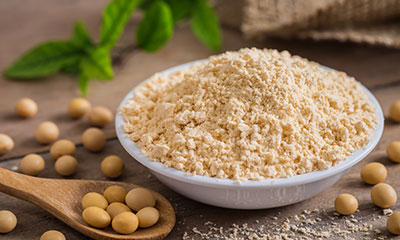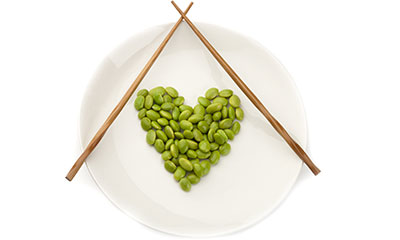USANA was founded with a mission to manufacture the highest-quality products without compromise. Because poor manufacturing can destroy great science, USANA is one of the few companies to manufacture most of its products in its own state-of-the-art facility. Join us for a tour and take a look at how we ensure that the formulas developed in USANA’s laboratories are produced consistently and how the same process is followed each time manufacturing begins.
There are several reasons it can be beneficial to take dietary supplements with food or a complete meal.
- One reason is to buffer the stomach (especially important for those with sensitive stomachs).
- Another reason is to increase consistency and compliance with the recommended dosage. Many people find it easier to form a habit of taking supplements alongside a meal, as opposed to taking them separately.
- Perhaps the best reason to take supplements with a meal is that some nutrients (e.g. fat-soluble nutrients and calcium) typically have improved absorption when taken with a meal or snack.
USANA Health Sciences operates in numerous countries around the world. So, USANA must meet the manufacturing and regulatory standards of each country to sell products there. Examples of these include the U.S. Food and Drug Administration (FDA) and the Australian Therapeutic Goods Administration (TGA).
The FDA requires dietary supplement manufacturers to follow Good Manufacturing Practices (GMP) for dietary supplements (21 CFR, part 111). USANA meets and exceeds these standards by voluntarily using the more stringent GMP for pharmaceuticals (21 CFR, part 211) as the model for its quality-assurance program. This model regulates virtually every aspect of manufacturing, including facility design and maintenance, raw material specification and control, supplier validation, product design, product testing, and more.
Here are just a few of the ways USANA meets or exceeds the dietary-supplement requirements:
- Raw-material-supplier quality is reviewed by USANA’s Quality Assurance before suppliers are approved to provide ingredients for use.
- Samples incoming raw materials in-house by a statistically sound sampling plan. This ensures tests are representative of the entire lot of material received.
- Has a state-of-the-art laboratory on-site. It’s staffed by qualified scientists, who ensure the identity, purity, and potency of each ingredient and finished product, as well as the absence of contamination.
- Keeps an extensive library of product records and standard operating procedures to ensure quality is guaranteed for every batch.
- Coordinates a robust stability program to ensure products meet label claims throughout the product shelf life.
Since 2018, USANA’s Salt Lake City, Utah, manufacturing facility has been certified by United States Pharmacopeia (USP) to meet the applicable GMP requirements (set forth in the 21 Code of Federal Regulations, Part 111, and in USP General Chapter 2750). And, where applicable, USANA tests its supplements to make sure they meet USP standards and specifications for potency, uniformity, and disintegration.
As an Australian supplier, USANA is regularly inspected and audited by the TGA to ensure their GMP standards are met. TGA mandates that manufacturers follow a set of GMP similar to pharmaceutical GMP in the United States.
Since 2006, USANA’s Salt Lake City, Utah, manufacturing facility has been certified to be in compliance with NSF/ANSI Dietary Supplement GMP requirements set forth by NSF International. According to NSF, “GMP registration reflects [a] continued commitment to ensuring quality and satisfaction and gives companies confidence that their organization operates in conformance to established GMP.”
In addition, a number of USANA supplements have been evaluated and approved by ConsumerLab.com, a leading provider of independent test results and information.
USANA is also a member of the United Natural Products Alliance (UNPA)—an association of dietary-supplement and functional-food companies that share a commitment to provide consumers with natural health products of superior quality, benefit, and reliability.
It is USANA’s mission to develop and provide the highest quality, science-based products. Because poor manufacturing can destroy great science, USANA is one of the few companies to manufacture most of its products in its own state-of-the-art facility. To ensure the formulas developed in USANA’s laboratories are produced consistently, the same process is followed each time manufacturing begins. By rigorously testing each product for potency and purity and by following pharmaceutical GMP, USANA has set the standard for excellence in dietary supplement manufacturing.
While the US Food and Drug Administration (FDA) regulations for dietary supplements are different than those established for medications and over-the-counter drugs, the dietary supplement industry is still regulated. The Dietary Supplement Health and Education Act (DSHEA) was established in 1994 and established a set of safety and regulatory standards for all dietary supplements. One of the regulations in place is that the FDA requires a safety notification process for any new dietary ingredients to be used in a supplement. Manufacturing facilities must be registered with the FDA, and comply with cGMPs (current good manufacturing practices) for quality control. Any structure/function or health claims made about a product must be submitted to the FDA along with a correct product label. The FDA or the FTC can also take regulatory action against any company making false or untruthful claims about their products.
For a little bean with a deep history, soy certainly attracts a lot of questions and controversy. But what are the facts about soy? Let’s start at the beginning.
Soy is a type of legume that has been part of traditional Asian diets for thousands of years. Evidence suggests soybeans were cultivated in China as early as 9,000 BC. And it’s rich in many nutrients including B vitamins, fiber, potassium, magnesium, high-quality protein, and certain phytonutrients.
Soy remains quite popular in Asia where it remains an integral part of many traditional diets and foods including tofu, tempeh, miso, and natto. In addition, soy and soy foods fit into many current food trends; including the increased popularity of plant- based diets and plant-sourced proteins over animal-derived sources; its role in promoting healthier lifestyles; and its convenience for use in functional foods.
In addition to its popularity in Asian cultures, it’s been a long-time dietary staple for vegetarians, vegans, and those who must avoid or are allergic to dairy foods. Soy foods like tofu, soy milk, miso, tempeh, and edamame are dietary basics for many. And unlike most other plant-based options, soy provides a complete protein.
Health experts agree that adding more plant protein to your diet is good for your health. So, why has this little bean become so controversial? Let’s review some questions, controversies, and benefits to find out more about soy.
A Summary of the Facts About Soy
- Soy is a complete and nutritious source of protein, so it’s a good alternative to animal-based proteins.
- It provides a number of phytonutrients linked to long-term health.
- Soy beans are a good source of fiber. Fiber supports a healthy gastrointestinal system, maintaining a healthier weight, and heart health.
- Some of the compounds in soy can interfere with certain physiological processes (phytates and enzyme inhibitors). But this is not unique or cause for alarm since most whole plant-based foods contain similar compounds. And, if nutritional science has taught us anything it is that a diet rich in whole, plant-based foods is generally protective against chronic disease and generally health promoting.
- Soy foods containing isoflavones appear protective for health. Particularly when consumed lifelong. Healthy dietary intakes of soy isoflavones, as reflected in Asian diets, appear to be in the range of about 20-80 mg per day.
- High rates of soy isoflavone intake (>150 mg per day) through consumption of isoflavone-fortified foods and supplements should generally be avoided. This is particularly true for menopausal and post-menopausal women at risk for estrogen-dependent breast disease and those who have not regularly eaten soy foods in the past.
- Clearly, there are people who are allergic and/or sensitive to soy. Those individuals need to limit their intake of soy or avoid it all together. But the scientific research indicates that this group is relatively small. That said, each of us is the best judge of what foods we should eat.
- If you experience side effects from eating soy foods (even if you don’t have a diagnosed soy allergy), it makes sense to minimize or eliminate sources of soy intake.
- When it comes to soy (or any food), it is important to maintain a sense of perspective. The relationships between diet and health risks are complex. And there may never be a complete set of answers to the questions concerning soy and long-term health. But, the weight of the scientific evidence clearly indicates that soy foods—whether whole or prepared from soy protein isolates—can be safely consumed in moderation by the vast majority of healthy people as part of a healthy, well-balanced diet.
- The most solid, common sense advice is to include protein from a wide variety of sources. You can turn to whole foods like legumes, whole grains, meat, dairy, and fish. But healthy processed foods are also an option. In this context, soy, whey, and other protein isolates and concentrates can all play a role as components of healthy, well-balanced diets.
In conclusion, it’s important to become better informed about what you put in your mouth and how it could impact your health. This includes seeking out objective information from reputable sources concerning the foods you eat. It’s easy to find information online about soy, but it’s more difficult to determine its accuracy. A few good sources to include when searching for information include: The Linus Pauling Institute’s Micronutrient Information Center, PubMed, The Soy Institute, Nutrition.gov, and The Nutrition Source- Harvard.edu.
What are Phytonutrients and Why are They Important to Understanding Soy’s Health Connections?
Phytonutrients are compounds made by plants for protection against their environment. They’re not necessary to sustain human life like essential macro- and micronutrients, but phytonutrients are beneficial for health. Of the thousand-plus known phytonutrients, the isoflavones found in soy are some of the most well-known.
Isoflavones are a group of phytonutrients that contain compounds with very weak estrogenic activity (phytoestrogen). While many plants consumed by humans contain phytoestrogens, soybeans and soy products are a rich source in the human diet.
Concerns About Soy
Does Soy Contain Estrogen?
Two of the primary soy isoflavones are genistein and daidzein. Both can act as antioxidants to help neutralize free radicals. They can also bind with estrogen receptors in a variety of tissues even though they display very weak estrogenic activity, about 1/400 to 1/1,000 the level of estradiol (human-produced estrogen). To date, studies have not found solid evidence that the weak amounts of isoflavones from soy interfere with human hormone levels—including estrogen. In fact, a large, meta-analysis of randomized controlled trials found no effect from consuming soy isoflavones on the circulating concentrations of estrogenic hormones in postmenopausal women.
Isoflavones can be viewed as beneficial or problematic. And like many nutrients, moderate intakes may provide health benefits, while excessive amounts could potentially be concerning. An epidemiological study of women living in the United States found the dietary intake of phytoestrogens in healthy, post-menopausal, Caucasian women was less than one milligram (mg) per day.
Soy is not the only food that contains phytoestrogens. Other foods that contain varying amounts of phytoestrogens include:
| Millet | Barley | Flax seed | Lentils |
| Kidney beans | Lima beans | Rye | Clover |
| Fennel | Chickpeas (garbanzo beans) | Apples | Alfalfa sprouts |
| Celery | Parsley | Beets | Bok choy |
| Broccoli | Cauliflower | Carrots | Cucumbers |
| Mushrooms | Brussels sprouts | Seaweed | Squash |
| Pumpkin seeds | Sunflower seeds | Cherries | Olives |
| Pears | Plums | Tomatoes | Prunes |
| Oats | Brown rice | Wheat germ | Bulgur |
| Brewer’s yeast | Black-eyed peas | Mung bean sprouts | Navy beans |
Is Soy Healthy For Men?
Because soy contains phytoestrogens, men may worry about including it in their diet. It’s important to note that while estrogens are hormones with an important role in a woman’s reproductive system, men also produce some estrogens too. This just happens at much lower levels.
Studies to date indicate that soy doesn’t negatively impact the production of testosterone in men. A 2010 meta-analysis examined the relationship between soy foods, soy protein powders, isoflavone supplements, and men’s reproductive hormones, including testosterone. The researchers concluded soy intake didn’t significantly affect testosterone levels. And other study suggests a supportive role for soy in maintaining prostate health.
Many generations of Asian males have consistently incorporated soy into their diet with no apparent detriment to their health. However, men concerned about soy and its potential impact on their reproductive health should consult with a healthcare provider.
Can Soy Cause Allergies?
A food allergy occurs when your immune system reacts to a protein in food that it mistakes as a threat. Symptoms can range from mild to life-threatening. Soy is on the Food and Agriculture Organization’s list of the eight most prevalent food allergens. In addition to soy, this list also includes also includes milk, eggs, fish, crustacea, wheat, peanuts, and tree nuts. Together, these foods account for about 90 percent of all food allergies. But it’s important to note that these high-profile food allergies differ widely in their incidence, severity, and symptoms. Soy protein—relative to milk and nut proteins, for example—is a relatively milder allergen for many.
Consider the following:
Milk and peanut allergies are each about six times more prevalent than soy allergies. In fact, the true incidence of soy allergy—as confirmed by double blind, placebo-controlled food challenges—is quite low. Research indicates that allergic reactions to soy occur predominately in children less than four years of age, and most estimates agree that <1.0 percent of children (probably 0.2-0.4 percent of children) have true soy allergies. Moreover, 90 percent of children who have reactions to soy outgrow the allergy by age four. Given these statistics, it is safe to assume that <0.1 percent of adults (less than 1 in 1,000) are allergic to soy.
Food allergen reaction thresholds, or the minimum oral dose of protein that elicits an allergic response, tends to be several orders of magnitude (more than 100-1,000 times) higher for soy than for milk and peanut proteins. In other words, it takes 100-1,000 times more soy protein than milk or peanut protein to initiate an allergic response in most sensitive people.
Soy allergies also tend to produce milder symptoms relative to other food allergies in most people. In a summary report of clinical food challenge studies, it was noted that, in 80 percent of reported cases, symptoms of soy allergies were minimal to mild. The remaining 20 percent were moderate. Severe allergic reactions to soy were less common. In comparison, milk and peanut allergies produced minimal-to-mild symptoms in 50-70 percent of cases, moderate symptoms in 20-30 percent of cases, and severe symptoms in 10-15 percent of cases.
In summary, soy proteins can produce allergic reactions in some people. But, relative to milk, peanut, and the other high-profile food allergens, reactions to soy are less common, more difficult to trigger, and typically less severe.
Those with a soy allergy should still avoid or limit the following foods: cold-pressed, expelled or extruded soy oil; edamame; miso; natto; shoyu; soy (soy albumin, soy cheese, soy fiber, soy flour, soy grits, soy ice cream, soy milk, soy nuts, soy sprouts, and soy yogurt); soya; soybean (curd, granules); soy protein (concentrate, hydrolyzed, isolate); soy sauce; tamari; tempeh; textured vegetable protein (TVP); and tofu.
Beyond true allergic reactions, some people may be sensitive to the “non-digestible” sugars and fiber in soy. These components can cause abdominal bloating and gas, just like the sugars and fibers found in most beans and the lactose in milk. With soy, such symptoms are generally reduced, if not eliminated, with highly refined soy protein isolates. These are 90-92 percent soy protein and only 3-4 percent carbohydrate (fiber, plus simple and complex sugars and starches).
Is All Soy Genetically Modified?
Genetic engineering of foods for human consumption has been a topic of interest and ongoing debate for quite some time. Any organism whose genetic material has been altered using genetic engineering techniques are considered genetically modified organisms (GMOs). Soybeans are the most widely genetically modified crop worldwide, representing half of all worldwide biotech crop acreage.
But not all soy is GMO. Consumer demand for non-GMO and organic soy has created a niche for farms to grow non-GMO crops—including soy. If you’d like to check the status of a product (with or without soy), non-GMO status of foods can be traced through a process called the Identity Preserved (IP) system. Identity preservation and traceability systems provide verification through every stage of crop development—from seed to distribution—to help ensure foods grown and labeled as organic or non-GMO are what the consumer receives.
What’s Soy’s Impact on the Environment?
Soy carries a number of advantages that can help reduce its environmental impact as a protein source. These positives, in turn, mean that soy—when consumed is as part of a balanced diet—can help reduce the collective environmental impact of protein in the human diet.
One advantage is the soybean plant’s ability to fix nitrogen from the atmosphere and require little (if any) nitrogen fertilizer. In addition, by using crop rotation planting techniques—alternating soybeans with corn and other crops on a given piece of farm land—soy production can reduce the amounts of nitrogen fertilizers needed by those alternating crops. Another advantage is that soy is a plant-based source of protein that is as complete, balanced, and nutritionally rich as most animal proteins. And soy does this at a much lower environmental cost.
Including soy as a significant source of dietary protein helps us eat lower on the food chain to help reduce our dietary environmental impact.
Can Soy Impact Thyroid Function?
The relationship between soy consumption and thyroid function has been well studied. The interest in this topic grew during the 1950s and 1960s when several cases of goiter were identified in infants who consumed soy formulas. Subsequently, using in vitro and animal research, scientists found that high concentrations of soy isoflavones genistein and daidzein can inhibit the activity of key enzymes involved in thyroid hormone biosynthesis.
More recently, data from 14 human clinical trials evaluated the effects of soy foods and soy isoflavones on thyroid function. These studies involved presumably healthy subjects, and, with few exceptions, the soy product used was isolated soy protein.
All of the studies but one showed either no effects or minor and clinically irrelevant effects of soy on thyroid function. The one trial that noted marked anti-thyroid effects (and the one often cited in anti-soy literature) involved Japanese adults who were fed roasted soybeans that had been pickled and stored in rice vinegar. The soy protein and isoflavone content of this food was not characterized, and the study involved no control group. As such, its relevance must be questioned.
One large study evaluated the specific effects of soy isoflavone supplements on thyroid function. Postmenopausal women between the ages of 64 and 83 were given daily doses of 90 milligrams (mg) of soy isoflavones or a placebo. Thyroid hormone levels were tested at baseline and again at 90 and 180 days. After six months, any differences in thyroid hormones between the groups were statistically indistinguishable.
Asian populations have a long history of consuming soy products without significant occurrence of goiter. This also holds true for vegetarians who consume higher amounts of soy coupled with high amounts of fruits and vegetables that contain flavonoids known to inhibit thyroid enzyme activity. These flavonoids include kaempferol (found in apples, onions, and green tea), naringenin (found in citrus fruits), and quercetin (found in fruits and berries). Such compounds are widely distributed in plant-derived foods and consumed at relatively high levels (up to one gram or more per day) by vegetarians and vegans. Despite this, vegetarian diets have not been linked with a decrease in thyroid function.
Today, most experts agree soy foods and isolated soy protein have little if any effects on thyroid function in normally healthy adults. And this is further backed by a 2019 review and meta-analysis published in the journal Nature that found soy supplementation had little to no effect on the thyroid hormones in healthy people. However, this does not apply to those with compromised thyroid function and/or people with suboptimal iodine status.
The truth about soy is that it’s a healthy food and a good source of protein that can be consumed in moderation by most healthy people as part of an overall nutritious diet. Concerns about eating soy with certain medical conditions, and medications that affect the thyroid gland should be discussed with a physician or other healthcare provider.
Does Soy Contain Phytates?
Phytate, or phytic acid, is a naturally occurring compound found in all plant foods like beans, grains, nuts, and seeds. Plants store phosphorus—an essential nutrient for plants and animals—in their seeds to support the growth of young seedlings. This phosphorus is stored in the form of phytate (inositol hexametaphosphate).
In the past, there were concerns that foods high in phytates might reduce the absorption of essential minerals like iron and zinc in the gut. Others, however, consider phytates to be important food constituents that act as natural food-preserving antioxidants that also help preserve health.
Soybeans contain approximately 1.3-2.22 grams of phytate per 100 grams (of dry weight). While some may consider this a reason to avoid soy foods, it is important to note that most whole grains, beans, seeds, and nuts are also rich in phytates. There is a wealth of science to support the fact that these foods (just like soy) are important constituents of a healthy, well-balanced diet that supports health and longevity. As such, it is difficult to argue that soy should be avoided based on its phytate content when so many other healthy foods contain comparable amounts of phytates.
Soy is not the only food that contains phyates/phytic acid. Amounts of some common foods (in grams per 100 grams of dry weight) are show below:
| Soy bean | 1.0-2.22 |
| Corn | 0.72-2.22 |
| Kidney beans | 0.61-2.38 |
| Oat | 0.42-1.16 |
| Wheat | 0.39-1.35 |
| Chick peas | 0.28-1.60 |
| Rice | 0.06-1.08 |
| Almonds | 0.35-9.42 |
| Walnuts | 0.20-6.69 |
| Peanuts | 0.17-4.47 |
| Walnuts | 0.20-6.69 |
| Cashews | 0.19-4.98 |
| Sesame seed | 1.44-5.36 |
In conclusion, there’s no evidence to support an increased risk of vitamin or mineral deficiencies from consuming soy.
What are the Benefits of Soy?
Japan has the highest number of people per capita living well into their 100’s. Studies show that a traditional Okinawan diet plays an impressive role in this longevity. Tofu and other soy products are a staple of this healthy way of eating. And studies show that people who eat soy products in place of animal protein maintain healthier blood lipid profiles within the normal range.
In addition, soy is one of the most researched foods on the planet with close to 14,000 papers published on soy referenced in PubMed. Epidemiological research suggests that soy consumption is associated with reduced risk of certain diseases, but the mechanisms underlying these relationships are unclear. More recent research suggests that the health benefits of soy may depend on your body’s ability to convert these isoflavones to key metabolites during digestion. Furthermore, the makeup of your microbiota can also influence the biological effects of isoflavones in your body.
Just like other protein sources, once digested soy protein becomes a group of amino acids used for building and repairing tissues, the synthesis of hormones and neurotransmitters, hormone and enzyme production, immune system support, and energy production—to name a few. Is soy itself beneficial, or do these protective associations exist because those who eat higher amounts of soy also eat lower amounts of animal protein and fat? Both factors are likely involved, but enough research exists to indicate that soy protein and soy isoflavones likely provide some direct benefits.
Soy Is a Complete Protein
Unlike most other plant proteins, soy protein is considered a complete protein. That means it contains all nine essential amino acids. Histidine, isoleucine, leucine, lysine, methionine, phenylalanine, threonine, tryptophan, and valine cannot be made by the human body and must be obtained from food.
There’s a measuring stick for determining the completeness of a protein. The Protein Digestibility Corrected Amino Acid Score (PDCAAS) is an international standard used for assessing protein quality. This approach considers the amino acid balance of a given protein as it compares to the amino acid needs of humans, with specific reference to 2-5-year-old children. It also takes into account the digestibility of the protein (how fully the protein is broken down and absorbed). The PDCAAS scale stretches from 0.0 to 1.0, with a score of 1.0 indicating the protein completely satisfies human needs from a quality perspective.
The PDCAAS method finds that soy protein isolates, whey protein isolates, and egg white protein all score a complete 1.00, meaning they all exhibit very high—and essentially equivalent—nutritional value in supporting human health.
The high PDCAAS score for soy protein isolates speaks to two important points. First, soy protein is well digested and absorbed by humans. (This is the “D” of PDCAAS). Second, soy protein is complete. It contains all the essential amino acids in a proper balance for human growth, development, and health. (This is the “AA” of PDCAAS.)
In 1999, soy protein was granted an FDA-allowed health claim: 25 grams of soy protein a day, as part of a diet low in saturated fat and cholesterol, may reduce the risk of heart disease. And in 2015, Health Canada approved a similar soy and heart health claim.
But that doesn’t mean soy is the best protein source for everyone. People who are allergic or sensitive to soy, or have certain medical conditions, should avoid or limit their intake of soy protein. Just like when people are allergic to dairy or rice, they should avoid those protein sources.
Soy is one of many high-quality protein sources available to consumers, and regularly consuming soy as part of a healthy diet may benefit health. But a healthy well-balanced diet should include protein from a wide variety of whole-food sources (legumes, whole grains, meat, dairy, and fish) and from healthy, processed foods.
Cardiovascular Health
Soy protein consumption has been linked to supporting healthy cholesterol levels, given they were already in the normal range, especially when replacing diets high in animal protein.
While the FDA granted an authorized heart health claim for soy protein in 1999, the evidence is now under further FDA review. A 2019 meta-analysis, using the same data FDA selected to approve the original heart health claim, found continued significance of the data that still strongly supports the rationale behind the original FDA soy heart health claim. It’s important to note that Health Canada approved a similar heart health claim for soy in 2015. And currently Health Canada has no plans to re-evaluate the evidence regarding soy protein and the heart health claim established in 2015.
Soy isoflavones may also play some role in maintaining vascular function and arterial flexibility, but the clinical significance of these health benefits of soy have not yet been clearly defined.
Bone Health
As good sources of protein and calcium, soybean-based foods are bone-friendly additions to the diet. There is some clinical evidence that soy protein and soy isoflavone-rich diets may have bone-supporting effects. Bone fracture rates are generally lower among Asian populations that regularly consume soy foods than among Western populations that seldom consume soy foods.
The evidence is mixed, however, leading some experts to have diverging opinions. They conclude soy foods and isoflavones shouldn’t be used as sole approaches to stop or slow down age-related bone loss. But they can be encouraged as part of an overall healthy lifestyle plan that also includes ensuring calcium and vitamin D adequacy and regular participation in weight-bearing exercise. Both of which encourage stronger and healthier bones.
The optimal amounts and types of soy foods needed to support bone health are not yet clear. However, evidence suggests regular consumption is likely useful for maintaining optimal bone health as an important part of an overall dietary pattern rich in whole plant foods.
Breast Health
The two primary isoflavones in soy are genistein and daidzein. Both are thought to be protective for breast tissue. That’s partially because each of these compounds act as antioxidants that help to neutralize free radicals within the body. Additionally, these isoflavones are similar in structure to estrogen and are able to bind with estrogen receptors in various tissues (particularly the estrogen receptor-β).
Even though these isoflavones exhibit weak estrogenic activity, they may be protective by binding estrogen receptors and blocking the harmful effects of the more potent form(s) of estrogen. This is how genistein and daidzein can function as overall antiestrogens. Several epidemiological studies have specifically examined the association between soy consumption and breast health. Many—but not all—have shown soy intake can be protective for breast health. Women who are concerned about maintaining their breast health should discuss the use of soy and soy isoflavones with their doctor or other healthcare professional.
Menopausal Health
Epidemiological evidence shows that diets rich in soy are associated with milder menopausal symptoms. A study of women in south-east Asian countries who traditionally consume a substantial amount of soy found that the prevalence of hot flushes and sweating was lower than experienced in western countries. Other research shows that soy-based isoflavones are moderately effective in relieving menopausal symptoms such as hot flashes, but it requires consistent use, and can take up to a year to see a moderate benefit.
The microbiome is thought to play an important role in the metabolism of soy isoflavones, and in how well soy helps ease menopausal symptoms. Research indicates that women whose intestinal bacteria have the ability to convert daidzein to S-equol– a bacterial metabolite of the soy isoflavone daidzein– have better menopausal relief from soy supplementation compared to women who don’t. Equol is formed from daidzin/daidzein by bacteria in the lower part of the gut. Dietary habits and an individual’s microbial communities may influence the efficiency of this production.
These differences may help explain the inconsistencies for soy’s benefits on individual health.
While studies have shown mixed results on the benefits and outcomes of using soy and soy isoflavones for relief of menopausal symptoms, isoflavones from soy and other herbals can be a valuable non-hormonal option for women who are either reluctant, or unable to use prescription hormone replacement therapy. The safety and benefits of these plant isoflavones, combined with their support of overall health, makes them an important option for women who are experiencing an end to their reproductive years.
Weight Loss
Soy protein has been effectively used as part of weight-loss diets for more than 20 years. Animal studies have shown soy protein and its associated bioactive isoflavones and peptides can have beneficial effects on glucose metabolism, fat metabolism, insulin sensitivity, metabolic rate, food intake, and weight loss. Studies in humans have further shown increasing the intake of soy or animal protein can increase metabolic rate, decrease appetite, and increase satiety.
Furthermore, randomized clinical trials and clinical weight-loss studies have shown diets based on soy protein are every bit as effective—if not more—than diets based on dairy protein. This is in relation to weight loss and reducing body fat.
The truth is that weight loss is much more a function of reducing caloric intake and increasing calories burned through exercise, as opposed to simply using soy or whey protein in the diet. But the ability of protein and fiber to help you feel fuller for longer can help in maintaining that healthy calorie balance.
What’s the Difference Between Fermented Soy Foods and Non-Fermented Soy Foods?
There are two principal categories of traditional soy foods: non-fermented and fermented. The main non-fermented foods include soy milk, tofu (bean curd), soybeans, and soynuts. These foods are consumed mainly for nourishment. The main fermented soyfoods include soy paste (miso in Japan) and fermented soybeans (natto in Japan). Fermented soy pastes are generally used as condiments in cooking, whereas fermented soybeans are also consumed as part of a meal.
There is not currently scientific agreement as to which type of soy is superior. The following are points to consider:
Fermenting soy foods increases isoflavone bioavailability. However, it also decreases the actual isoflavone content of the food. Typical intakes of non-fermented soy foods are higher than fermented soy products and would contribute a much larger percentage of dietary isoflavones. But fermented soy may be easier for some to digest, although digestion of non-fermented products is not a common problem.
Fermented products also have lower phytate levels. However, this is not a major issue since mineral levels of people eating a typical mixed diet are not significantly affected by the phytic acid content in non-fermented soy. Also, fermented soy products can be quite high in sodium, which can be detrimental to overall health.
So, the published scientific literature has generally made no distinction in benefit between fermented and non-fermented soy foods. If anything, the majority of published soy research has involved non-fermented soy foods or products.
Optimal nutrition starts with a healthy, well-balanced diet that includes a wide variety of plant-based foods. In this light, perhaps the best way to take advantage of the health benefits of soy is to eat moderate amounts from a variety of fermented and non-fermented sources.
References and Suggested Reading
Ahsan M, Mallick AK. The Effect of Soy Isoflavones on the Menopause Rating Scale Scoring in Perimenopausal and Postmenopausal Women: A Pilot Study. J Clin Diagn Res. 2017;11(9):FC13–FC16.
Boulet MJ1, Oddens BJ, Lehert P, Vemer HM, Visser A. Climacteric and menopause in seven South-east Asian countries. Maturitas. 1994 Oct;19(3):157-76.
Bruce B, Messina M, Spiller GA. Isoflavone supplements do not affect thyroid function in iodine-replete postmenopausal women. 2003. J Med Food 6:309-16.
Chen LR, Ko NY, Chen KH.Isoflavone Supplements for Menopausal Women: A Systematic Review. Nutrients. 2019 Nov 4;11(11).
Cordle CT. Soy protein allergy: incidence and relative severity. 2004. J Nutr 134:1213S-9S.
Cotterchio M, Boucer BA, Manno M, Gallinger S, Okey A, Harper P. Dietary phytoestrogens intake is associated with reduced colorectal cancer risk. 2006. J Nutr 136:3046-53.
David J. A. Jenkins, Sonia Blanco Mejia, Laura Chiavaroli, Effie Viguiliouk, Siying S. Li, Cyril W. C. Kendall, Vladmir Vuksan, John L. Sievenpiper. Cumulative Meta‐Analysis of the Soy Effect Over Time. Journal of the American Heart Association, 2019; 8 (13) DOI: 10.1161/JAHA.119.012458
De Kleijn MF, van der Schouw YT, Wilson PW, Adlercreutz H, Mazur W, Frobbee DE, Jacques PF. Intake of dietary phytoestrogens is low in postmenopausal women in the United States: the Framingham study (1-4). 2001. J Nutr 131:1826-1832.
Divi RL, Doerge DR. Inhibition of thyroid peroxidase by dietary flavonoids. 1996. Chem Res Toxicol 9:16-23.
Doerge DR, Sheehan DM. Goitrogenic and estrogenic activity of soy isoflavones. 2002. Environ Health Prespect 110 Suppl 3:349-53.
Duffy C, Perez K, Partridge A. Implications of phytoestrogen intake for breast cancer. 2007. CA Cancer J Clin 57:260-77.
Fournier DB, Erdman JW Jr, Gordon GB. Soy, its components, and cancer prevention: a review of the in vitro, animal, and human data. 1998. Cancer Epidemiol Biomarkers Prev 11:1055-65.
Franco OH, Chowdhury R, Troup J, et al. Use of plant-based therapies and menopausal symptoms: A systematic review and meta-analysis. JAMA. 2016;315:2554-63.
Geller SE, Studee L. Soy and red clover for mid-life and aging. Climacteric. 2006;9(4):245–263.
Gutendorf B, Westendorf J. Comparison of an array of in vitro assays for the assessment of the estrogenic potential of natural and synthetic estrogens, phytoestrogens and xenoestrogens. 2001. Toxicology 166:79-89.
Hüser S, Guth S, Joost HG, et al. Effects of isoflavones on breast tissue and the thyroid hormone system in humans: a comprehensive safety evaluation. Arch Toxicol. 2018;92(9):2703–2748.
Hydovitz JD. Occurrence of goiter in an infant on a soy diet. 1960. N Engl J Med 262:351-3.
Lee HP, Gourley L, Duffy SW, Esteve J, Lee J, Day NE. Dietary effects on breast-cancer risk in Singapore. 1991. Lancet 337:1197-200.
Levis S, Griebeler ML. The role of soy foods in the treatment of menopausal symptoms. J Nutr. 2010;140(12):2318S–2321S.
Liu Z, Li W, Sun J, Liu C, Zenhjg Q, Huang J, Yu B, Huo J. Intake of soy foods and soy isoflavones by rural adult women in China. 2004. Asia Pac J Clin Nutr 13:204-9.
Marini H, Polito F, Adamo EB, Bitto A, Squadrito F, Benvenga S. Update on genistein and thyroid: an overall message of safety. Front Endocrinol (Lausanne). 2012;3:94.
Mayo B, Vázquez L, Flórez AB. Equol: A Bacterial Metabolite from The Daidzein Isoflavone and Its Presumed Beneficial Health Effects. Nutrients. 2019;11(9):2231.
McMichael-Phillips DF, Harding C, Morton M, Roberts SA, Howell A, Potten CS, Bundred NJ. Effects of soy-protein supplementation on epithelial proliferation in the histologically normal human breast. 1998. Am J Clin Nutr 68(Suppl):1431S-5S.
Messina M, Ho S, Alekel DL. Skeletal benefits of soy isoflavones: a review of the clinical trial and epidemiologic data. 2004. Curr Opin Clin Nutr Metab Care 7:649-58.
Messina M, McCaskill-Stevens W, Lampe JW. Addressing the soy and breast cancer relationship: review, commentary, and workshop proceedings. 2006. J Natl Cancer Inst 98:1275-84.
Messina M, Nagata C, Wu AH. Estimated Asian adult soy protein and isoflavone intakes. 2006. Nutr Cancer 55:1-12.
Messina M, Redmond G. Effects of soy protein and soybean isoflavones on thyroid function in healthy adults and hypothyroid patients: a review of the relevant literature. 2006. Hyuroid 16:249-58.
Montgomery KS. Soy protein. J Perinat Educ. 2003;12(3):42–45.
Munro IC, Harwood M, Hlywka JJ, Stephen AM, Doull J, Flamm WG, Adlercreutz H. Soy isoflavones: a safety review. 2003. Nutrition Rev 61:1-33.
Otun, J., Sahebkar, A., Östlundh, L. et al. Systematic Review and Meta-analysis on the Effect of Soy on Thyroid Function. Sci Rep 9, 3964 (2019).
Petersen KS1. The Dilemma With the Soy Protein Health Claim. J Am Heart Assoc. 2019 Jul 2;8(13):e013202.
Rafii F. The role of colonic bacteria in the metabolism of the natural isoflavone daidzin to equol. Metabolites. 2015;5(1):56–73.
Reddy NR, Sathe SK (eds). Food Phytates. 2001. CRC Press, Boca Raton.
Roberts P. The End of Food. 2008. Houghton Mifflin Co, New York.
Sacks FM, Lichtenstein A, Van Horn L, Harris W, Kris-Etherton P, Winston M. Soy protein, isoflavones, and cardiovascular health. 2006. Circulation, 113:1034-44.
Schlemmer U, Frølich W, Prieto RM, Grases F. Phytate in foods and significance for humans: food sources, intake, processing, bioavailability, protective role and analysis. Mol Nutr Food Res. 2009 Sep;53 Suppl 2:S330-75.Trock BJ, Hilakivi-Clarke L, Clarke R. Meta-analysis of soy intake and breast cancer risk. 2006. J Natl Cancer Inst 98:459-71.
Taku K, Melby MK, Kronenberg F, Kurzer MS, Messina M. Extracted or synthesized soybean isoflavones reduce menopausal hot flash frequency and severity: systematic review and meta-analysis of randomized controlled trials. Menopause. 2012;19:776-90.
Tuka K, Umegaki K, Sato Y, Endoh K, Watanabe S. Soy isoflavones lower serum total and LDL cholesterol in humans: a meta-analysis of 11 radomized controlled trials. 2007. Am J Clin Nutr 85:1148-56.
Wu AH, Ziegler RG, Horn-Ross PL, Nomura AM, West DW, Kolonel LN, Rosenthal JF, Hoover RN, Pike MC. Tofu and risk of breast cancer in Asian-Americans. 1996. Cancer Epidemiol Biomarkers Prev 11:901-6.
Yamamoto S, Sobue T, Kobayashi M, Sasaki S, Tsugane S. Soy, isoflavones, and breast cancer risk in Japan. 2003. J Natl Cancer Inst 95:906-13.
Yan L, Spitznagel E. A meta-analysis of soytfoods and risk of breast cancer in women. 2004. Int J Cancer Prevention 1:281-93.
Young VR, Pellett PL. Plant proteins in relation to human protein and amino acid nutrition. 1994. Am J Clin Nutr 59(suppl):1203S –12S.
Zhang Y, Song TT, Cunnick JE, Murphy PA, Hendrich S. Daidzein and genistein glucoronides in vitro are weakly estrogenic and activate human natural killer cells at nutritionally relevant concentrations. 1999. J Nutr 129:399-405.
Zuidmeer L, Goldhahn K, Rona RJ, Gisiason D, Madsen C, Summers C, Sodergren E, Dahlstrom J, Lindner T, Sigurdardottir ST, McBride D, Keil T. The prevalence of plant food allergies: a systematic review. 2008. J Allergy Clin Immunol 121:1210-8.
There is no conclusive clinical evidence to suggest that the amount of black cohosh extract in PhytoEstrin increases cancer risk in otherwise healthy women. For those undergoing chemotherapy or those with a history of breast cancer, many herbals and nutritional supplements may be inappropriate. We suggest you discuss these concerns with your physician or health care provider.
Although items in the popular press about black cohosh have implied a link to breast cancer growth, extensive reviews of existing literature and research has failed to corroborate such claims.
Based on a long history of safe use and many review articles involving thousands of study subjects, appropriate use of black cohosh is safe and without major side-effects for the vast majority of generally healthy adults.
None of USANA’s food or nutritional products contain added aluminum.
Some of the Sensé products contain aluminum in the form of magnesium aluminum silicate. Magnesium aluminum silicate is used as a slip modifier, an ingredient that helps other substances flow more easily and smoothly without reacting chemically. It is a naturally occurring mineral complex similar to bentonite, kaolin, and many other silicates.
Magnesium aluminum silicate has not been shown as genotoxic in oral acute or short-term oral or injection toxicity studies. Additionally, the ingredient is of even less concern topically, because its large molecular size prevents absorption into the skin.
The Sensé product line has been extensively tested under dermatologist and ophthalmologist-supervised conditions. All Sensé ingredients must comply with strict safety standards set by governmental regulations, which are overseen by the CTFA (Cosmetic Toiletry and Fragrance Association).
Most of the concern regarding smoking and beta-carotene comes from the CARET and PHS studies published in the late 1990s. It is important to understand that one set of study participants averaged 50 pack years of cigarettes (i.e. 4 packs a day for 12.5 years or 2 packs per day for 25 years). Another set of participants were already diagnosed with lung damage (due to chronic asbestos exposure). Given these conditions, both groups already had a high risk of lung cancer. In addition, both groups took very high doses of both beta-carotene and vitamin A.
Subsequent studies have been done using more moderate dosages of beta-carotene (similar to the dosage in the USANA CellSentials) alongside vitamin C and vitamin E. These results showed that when other antioxidants are added to beta-carotene supplementation, the results are quite different. In fact, when used in combination the antioxidants appeared to be protective against cancer progression – even in lung tissue exposed to smoke. These subsequent results support the common sense message USANA has always espoused: that supplements should be balanced, complete, and taken with a healthy diet.
For your convenience, we have included an abstract from a published paper on beta-carotene, carotenoids, and lung cancer incidence.
Cancer Epidemiol Biomarkers Prev. 2004 Jan;13(1):40-8
Dietary carotenoids and risk of lung cancer in a pooled analysis of seven cohort studies
Mannisto S, Smith-Warner SA, Spiegelman D, Albanes D, Anderson K, van den Brandt PA, Cerhan JR, Colditz G, Feskanich D, Freudenheim JL, Giovannucci E, Goldbohm RA, Graham S, Miller AB, Rohan TE, Virtamo J, Willett WC, Hunter DJ.
Harvard School of Public Health, Department of Nutrition, Boston, Massachusetts, USA.
Intervention trials with supplemental beta-carotene have observed either no effect or a harmful effect on lung cancer risk. Because food composition databases for specific carotenoids have only become available recently, epidemiological evidence relating usual dietary levels of these carotenoids with lung cancer risk is limited. We analyzed the association between lung cancer risk and intakes of specific carotenoids using the primary data from seven cohort studies in North America and Europe. Carotenoid intakes were estimated from dietary questionnaires administered at baseline in each study. We calculated study-specific multivariate relative risks (RRs) and combined these using a random-effects model. The multivariate models included smoking history and other potential risk factors. During follow-up of up to 7-16 years across studies, 3,155 incident lung cancer cases were diagnosed among 399,765 participants. beta-Carotene intake was not associated with lung cancer risk (pooled multivariate RR = 0.98; 95% confidence interval, 0.87-1.11; highest versus lowest quintile). The RRs for alpha-carotene, lutein/zeaxanthin, and lycopene were also close to unity. beta-Cryptoxanthin intake was inversely associated with lung cancer risk (RR = 0.76; 95% confidence interval, 0.67-0.86; highest versus lowest quintile). These results did not change after adjustment for intakes of vitamin C (with or without supplements), folate (with or without supplements), and other carotenoids and multivitamin use. The associations generally were similar among never, past, or current smokers and by histological type. Although smoking is the strongest risk factor for lung cancer, greater intake of foods high in beta-cryptoxanthin, such as citrus fruit, may modestly lower the risk.
Zeaxanthin belongs to a class of antioxidant compounds called carotenoids. In the eye, lutein is the predominant carotenoid (located in the periphery of the macula), while the concentration of zeaxanthin is greatest in the center, where conditions most favor the formation of free radicals.
Both lutein and zeaxanthin are important in maintaining eye health. In their capacity as pigments, these compounds help screen out high-energy light, protecting underlying tissues from photo-induced damage. They also act as antioxidants, helping to protect the macula from damage due to oxidative stress. Both functions can help reduce the risk of age-related eye disease.
Zeaxanthin is found in many food sources. Dark green leafy vegetables (such as spinach) are the primary source. Lesser amounts are available in other colorful fruits and vegetables, including broccoli, orange peppers, corn, peas, persimmons, and tangerines.
Turmeric (Curcuma longa) is a member of the ginger family and native to India and southeast Asia. The powdered root has a long history of use as a spice (especially in India and the Middle East), and it is also used as a natural food colorant and medicinal agent.
Turmeric contains three major phytochemical compounds – called curcuminoids – which give turmeric its bright yellow-orange color. (The most active component is curcumin.) These curcuminoids have been the focus of numerous clinical studies designed to investigate their long-term safety, antioxidant properties, and anti-inflammatory activity.
Thanks for sharing! Entering your USANA ID number creates a unique URL, which allows you to receive credit on referrals.
Here’s how it works: When the link is clicked, a cookie (if allowed) is created. Shopping buttons on applicable product pages will appear to the referred user. A click on these buttons passes your referral information to USANA’s Shopping Cart, tying purchases made on cookie-containing devices to you for 30 days. In addition, if a person clicks on this unique URL and then later visits USANA.com and makes a purchase (within 30 days), you receive credit for the sale.
Enter your ID now for these enhanced features.










